Episesarma versicolor (Tweedie, 1940)
Brief Introduction
The violet vinegar crab or Episesarma versicolor is likely the most common Episesarma species in Singapore. There are five known Episesarma species which are found in Singapore. Episesarma Mederi (H .Milne Edwards, 1853), Episesarma palawanense (Rathbun, 1914), Episesarma singaporense (Tweedie 1936), Episesarma versicolor (Tweedie, 1940) and Episesarma chengtogense (Serene & Soh, 1967). Of the five known Episesarma species in Singapore’s Mangrove, four are known to be tree-climbing crabs (E. palawanense, E. versicolor, E. singaporense, E. chengtonense) (Sivasothi, 2000). These crabs are mostly found in the forest and in mud-lobster mounds during low tide and on trees during high tide. They feed mostly on leaves on the forest floor and occasionally feed on small dead animals. The Episesarma species are not evaluated under the IUCN red-list of threatened species however they are found in mangroves which are being lost rapidly hence may be of attention in the future. Although the violet vinegar crabs eaten as a popular Teochew dish in the past, it has seen declining popularity therefore it being an ingredient will not be much of a strain on the population. However, it is not known if the violet vinegar crabs are still being heavily harvested in other countries such as Thailand which has the violet vinegar crab as a dish.
| Figure 1. Episesarma versicolor, taken at Sungei Buloh Wetland Reserve, Singapore. (Photo credit: Goh Yi Le) |
Biology
Global Distribution
Episesarma versicolor original type locality (place where specimen was found) is Singapore. It can be found across Southeast Asian countries - Southern China, Hong Kong, Malaysia, Philippines, Indonesia, Thailand; South Asian countries - Bangladesh, India, Sri Lanka. The violet vinegar crabs are also found in Northern Australia.Distribution in other countries
Although this page is focused on Singapore in particular, there are research papers which research was done with populations in Thailand and Tamil Nadu. An interesting point to note, minimum spanning network (MSN) was conducted on violet vinegar tree-climbing crabs along the Andaman seacoast of Thailand. The analysis revealed that there were 2 main lineages of the violet vinegar crabs; Clade 1 is a lineage of the Andaman coast and Clade 2 is a lineage of Krabi.Figure 2. Global distribution of E. versicolor
Distribution in Singapore
The violet vinegar tree-climbing crabs has been sighted at the following places in Singapore:- Jurong River (Tweedy, 1934)
- Mandai Mangrove (BY Lee, 2013)
- Lim Chu Kang Mangrove (CD Schubart et al., 2000), (BY Lee et al., 2010)
- Pasir Ris Mangrove (CMDS Expedition 1, 2012)
- Pandan Forest Reserve (Tweedy, 1934)
- Pulau Ubin Outward Bound School Camp 1 (CMBS expedition 1, 2012), (BY Lee & RRY Oh, 2011)
- Sungei Buloh Mangrove (N. Sivasothi, 2004)
- Serangoon River (Tweedy, 1939)
According to a map by Sivasothi and Kelvin on where the Episesarma species can be found, Jurong River and Serangoon River are not listed on the map while Pulau Tekong is listed. Hence the species may not be found in Jurong River and Serangoon River anymore.
Figure 3. Native distribution of E.versicolor in Singapore
Habitats
The violet vinegar tree-climbing crab, as with the other known tree-climbing crabs of Episesarma species, are frequently found in the forest of mangroves. Mangrove forests provides a variety of ecological niches for these crabs which separate in time and space to decrease interspecific competition for food (Fratini et. al., 2005). Large crabs dig burrows at mud base of mangrove trees which smaller crabs would hide during day low tide and night high tide. Rarely, they are found in inland mound system formed by Thalassina anomala (Herbst, 1804) or commonly known as mud lobsters.During high tide at day-time, E.versicolor are found motionless on trees slightly away from the waterline but not too high on top the tree. This exhibited behaviour from the crabs is due to them avoiding land and aqua predators (such as monitor lizards and otters) and to avoid flying predators (such as the white-collared kingfishers).
Figure 4. The violet vinegar crab on buttress root of a mangrove tree in Sungei Buloh (Photo: Goh Yi Le) Day: Low Tide Forest of mangroves In burrows |
Figure 5. The violet vinegar crab in tree-hole of mangrove tree in Sungei Buloh (Photo: Germaine Chua) Day: High Tide On trees (larger crabs) In burrows (smaller crabs) |
Figure 6. Inland mound system (Photo: Germaine Chua) Night: Low Tide Forest of mangroves Inland mud lobster mound |
Figure 7. Mangrove forest ground (Photo: Germaine Chua) Night: High Tide In burrows (inland) |
Diagnosis:
How to distinguish Episesarma versicolor from other species of Episesarma in Singapore's Mangroves.
Diagnostic traits between the chela (or more commonly known as the claw or pincer) of the male, chela colour and gonopod help distinguish between the five different Episesarma species found in Singapore. The chela of the violet vinegar crab (E. versicolor) is purple or violet. The dactylus and pollen is white in colour. The colour of the chela is the most distinct between all Episesarma species. Interestingly, some sample materials which were identified by Tweedie were initially thought to be Sesarma palawanensis (presently Episesarma palawanensis). These materials were actually mixed with Sesarma versicolor (presently E. versicolor) (Lee. B. Y. et al., 2015). Comparing E. versicolor in figure 8 and E. palawanense in figure 9, it can be seen that the dactylus (refer to figure 11) are both white in colour. and the chela colour are not too distinct from each other.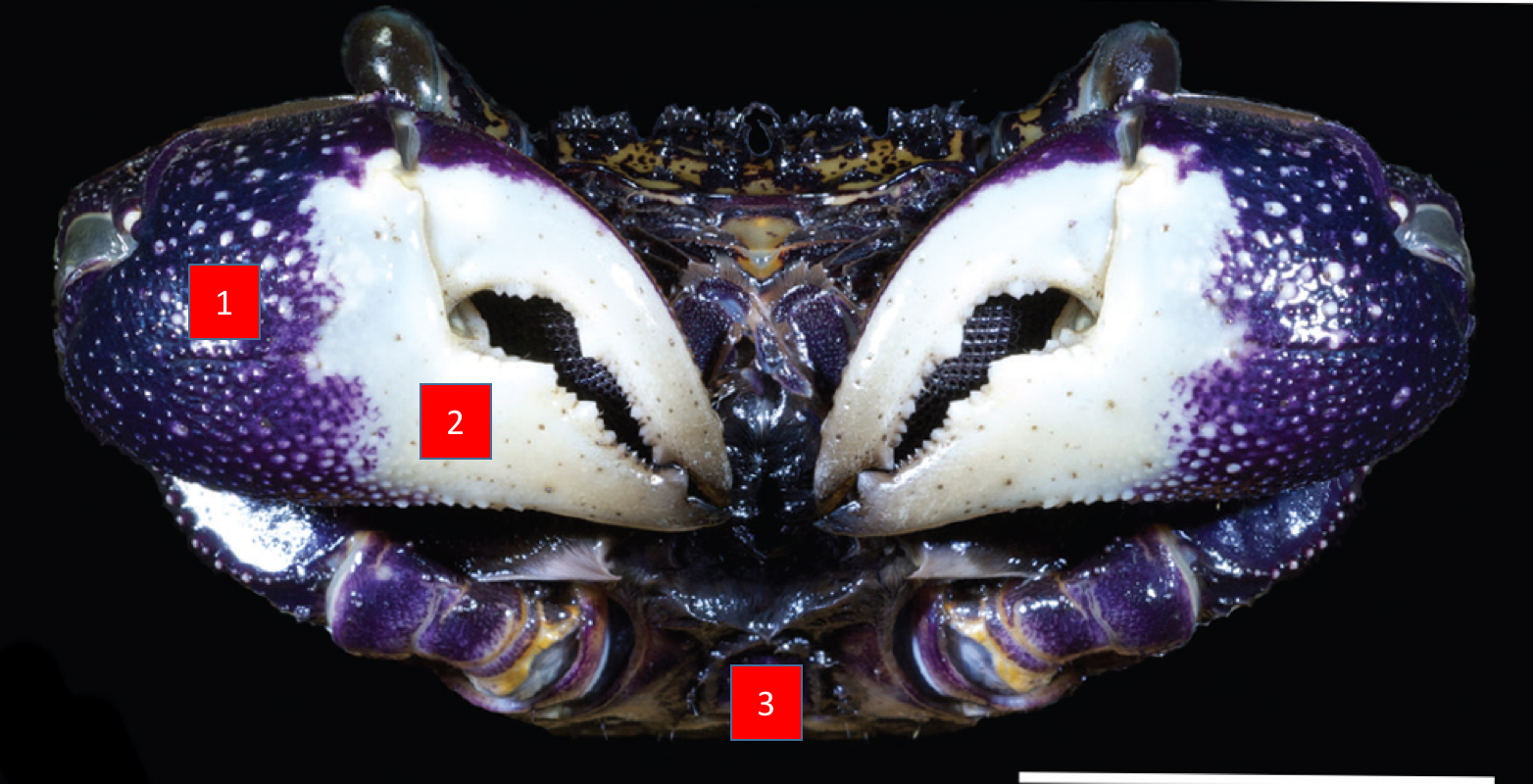

(Top left) Figure 8. Frontal view of a sexually mature male E. versicolor. Image credit: Tweedie, 1940. Annotations numbered by page author Hariz. Obtained from: The taxonomy of five species of Episesarma De Man, 1895, in Singapore (Crustacea: Decapoda: Brachyura: Sesarmidae) (Lee. B. Y. et al., 2015).
(Top right) Figure 9. Frontal view comparison between E. chengtonense and E. palawanense. Image credit: Tweedie, 1940. Obtained from: The taxonomy of five species of Episesarma De Man, 1895, in Singapore (Crustacea: Decapoda: Brachyura: Sesarmidae) (Lee. B. Y. et al., 2015).
(Bottom) Figure 10. Frontal view of a non - E. versicolor. Likely to be an E. singaporense or E. mederi. Here you can see that it is harder to distinguish between other species of Episesarma based on first look. Photo taken by Goh Yi Le.
First look at E. versicolor
- easily discernible diagnostic features are:
- Violet chela - a.k.a pincer/claw (labelled 1 in Figure 8)
- White finger tips (labelled 2 in Figure 8)
Closer Inspection:
- Dorsal (top view) margin (edge) of dactylar (pertaining to claw) finger of adult male chela with between 65 to 80 tubercles (small rounded projection).
- The number of tubercles are relatively constant within E. versicolor species as compared to other species of Episesarma which tubercles are relatively constant within the species.
- Vulvae with operculum (gill cover) slightly protruded distally (near label 3 on Figure 8 but unable to be seen in the image).
Limitations:
- There were no figures provided to support the description of the differences in chela colour between the five Episesarma species by Serene & Soh (1967a), hence subsequent intepretations only provides a subjective view.
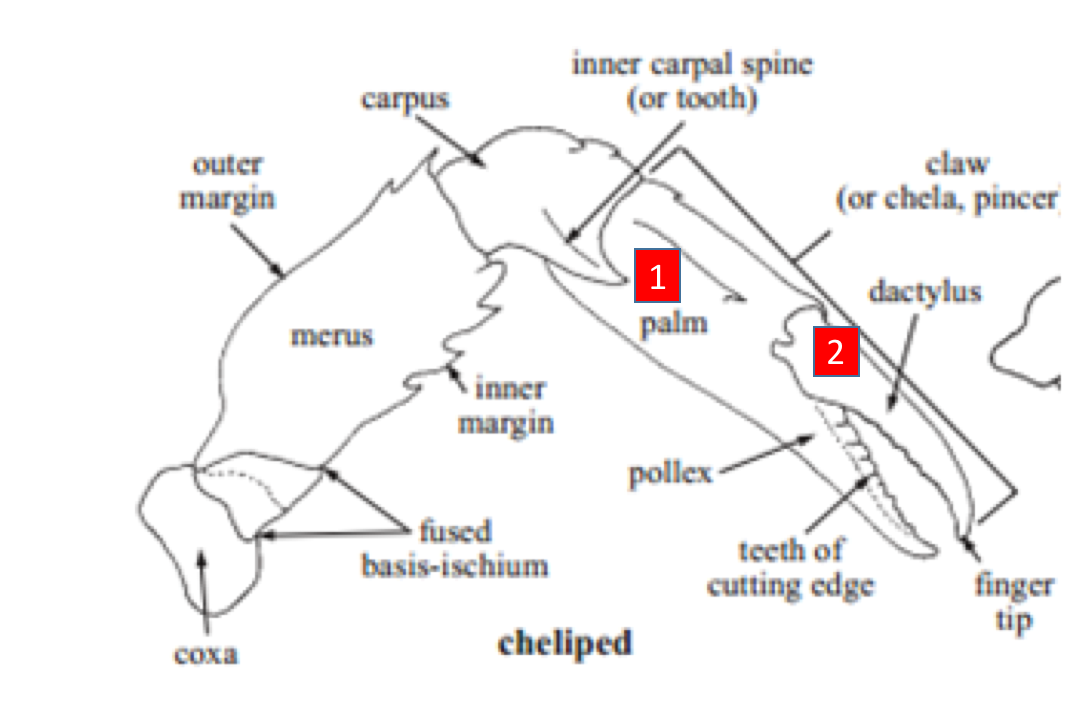
How to distinguish Episesarma species from other species of tree climbing crabs.
There are many morphological characteristics that are common in all tree-climbing crabs. Two of the most common features are that their overall body shape or carapace are conspicuously flattened and secondly their main legs have long propodi (second most distal segment, labelled 1 in Figure 11) and short dactyli (most distal segment, labelled 2 in Figure 11). However there is a stark difference in the shape of the carapace. The Episesarma species which are tree trunk climbers have a slightly more squared-shaped carapace while the other species which are tree canopy climbers have triangular-shaped carapace. However, the carapace of Selatium species of tree-climbing crabs do not differ much from the Episesarma species in terms of carapace shape (Fratini et. al., 2005).Biology
Behaviour
The Episesarma versicolor climbs a metre or two on top mangrove trees in the night or during high tide. The crabs are avoiding aquatic predators but they also forage diatoms or microphytes by scraping the bark of trees. When approached while on the trees, the crabs will drop off the tree.Feeding Habits
The Episesarma versicolor mainly feed on fallen dead leaves on trees and on the mangrove forest ground in the night. It also scavenges for small dead animals. Propagules and seedlings are also susceptible to attack by violet vinegar crab.Reproduction
The crab exhibit pre-copulatory courtship behaviour (Schram, 2010). The mature male have been sighted to carry the female before mating. This activity can be seen for as long as 190 days before mating. Burrowing allows the crabs to have a safe environment for activities such as mating. The different classifications of mating of the Brachyurans can be seen in this journal article by John H. Christy.Ecological services
The Episesarma versicolor species play an important role in mangroves by consuming and degrading organic matter, such as mangrove leaf litter, to keep energy within the forest as well as contributing its faecal matter to secondary production in a coprophagous food chain (consumption of faeces) (Gillikin and Schubart 2004). It is estimated that litter turnover is increased by approximately 750% more than the rate of microbial decay through litter processing by Episesarma versicolor (Robertson & Daniel, 1989).
Human uses
A popular Teochew Chinese food in the 1960s called Wa Kee, the crabs are pickled in vinegar or soy sauce. In Thailand, the crabs preserved in salt or fish sauce (called Poo Dong) and used in deep fried dishes or with papaya salad. It is a relatively cheap food in the past, where people in Southeast Asia would harvest them and eat them with porridge (Lim et.al., 1999).
Taxonomy and systematics
Taxonavigation
Ordo: Decapoda Familia: Sesarmidae Genus: Episesarma
| Table 1. Taxonomic Hierachy |
|
|---|---|
| Kingdom |
Animalia |
| Phylum |
Arthropoda |
| Subphylum |
Crustacea |
| Superclass |
Multicrustacea |
| Class |
Malacostraca |
| Subclass |
Eumalacostraca |
| Superorder |
Eucarida |
| Order |
Decapoda |
| Suborder |
Pleocyemata |
| Infraorder |
Brachyura |
| Section |
Eubrachyura |
| Subsection |
Thoracotremata |
| Superfamily |
Grapsoidea |
| Family |
Sesarmidae |
| Subfamily |
Macropodinae (Liem, 1963) |
| Genus |
Episesarma (Tweedie, 1850) |
| Species |
Episesarma versicolor (Tweedie, 1940) |
Name
Binomial nomenclature: Episesarma versicolor (Tweedie, 1940)
Vernacular (non-scientific name): Violet vinegar crab, Violet tree-climbing crab
Etymology: how the crab got its name
The crab's common name has reference to the recognisable colour of its chela (purple to violet) - hence violet in 'violet vinegar crab'. In the past, people in Southeast Asia used to gather these crabs for food. These crabs are traditionally dipped in vinegar before consumption - hence vinegar in 'violet vinegar crab'. See also: Human Uses above.
Synonyms
Sesarma versicolor: Tweedie, 1940
Description
Serene & Soh (1970) established a new genus including Neoepisesarma. They stated in the report "The new genus generally corresponds to the Indo-Pacific species of Sesarma which were included... ... in Episesarma by De Man (1895-1897)." With this, one problem example was that the designation of Tetragonum in Episesarma sp. (Rathbun, 1918) failed due to insufficient description of Episesarma (Neoepisesarma) by De Man in his original description.
However in 1978, Holthium showed that Episesarma de Man (1895) was synonymous with Neoepisesarma and that the former was the older name. Hence, species were referred to as Neoepisesarma was later revised back to Episesarma.
Size
Max length is 5.0cm at maturity (Ng, 1998).Coloration
The carapace is brownish-earthed in colour with some violet patches. For the chelae outer surface, the palm is violet at the proximal part while the distal part and the fingers are white. The flat and pointy legs are yellow in colour.Sexing
Adult males have caudal transverse bars - near the posterior end of Figure 8, and luminous versicolor / purple opercles (support for covering gills); fins tend to be stretched out. On the other hand, adult females and juveniles have an obvious chin-bar as well as two visible transverse bands converging on a dark spot at the caudal peduncle (Tan & Ng, 2005).Phylogeny
With the recent introduction of new taxa, the systematics of crabs which belong to the superfamily of Grapsoidea are still unsettled. Adult and larvae morphology as well as molecular techniques are commonly used in addressing the phylogeny and taxonomics of the Grapsoidea crabs. Gecarcinidae, Grapsidae and Ocypodidae were previously placed together with Grapsoidea and the separation into the three distinct superfamilies can be seen in Alcock (1900).
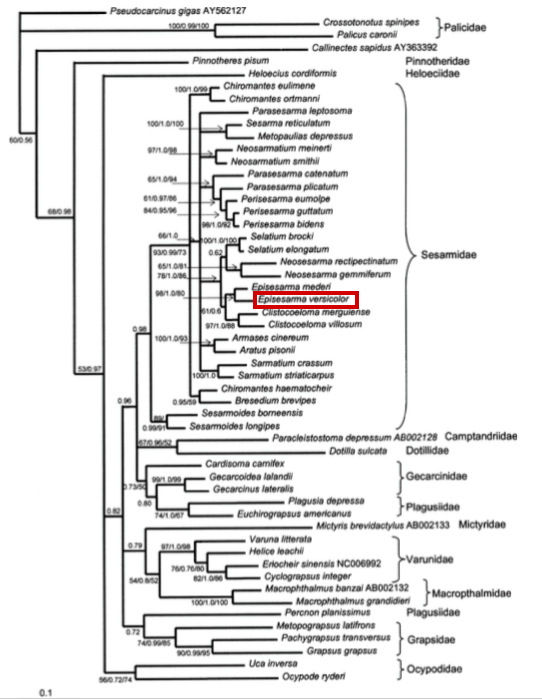
The phylogenetic tree above was constructed using 12S and 16S mitochondrial small and large ribosomal subunits. The alignment consist of 1095 basepairs after the removal of primers and uncertain alignment of hypervariable regions. The sequences were aligned using the software ESEE.
The tree includes grapsoid crabs from the Indian Ocean and uses DNA sequences of the tasmanian giant crab, Pseudocarcinus gigas (family: Menippidae) and blue crab, Callinectes sapidus (family: Portunidae) in the MP and NJ analysis and only the blue crab in the BI method. Only confidence values of 50% of more are included in the tree. Episesarma genus is nested within the Sesarmidae family. There are no support values for the Episesarma genus however the node before the node which splits the Episesarma genus and Clistocoeloma genus has a bootstrap value of 61 (MP).
In a study by Fratini et al., the 12S and 16S mitochondrial ribosomal subunits were used to study the phylogenetic relationships among tree-climbing crabs species. The crabs used were from the mangroves of America, West Africa, East Africa and Southeast Asia. The first null hypothesis was that the tree-climbings crabs which lived on tree canopy (TC species) are monophyletic (Episesarma species are TT species - live on tree trunks). The second null hypothesis was the monophyly of all sesarmid tree-climbing crabs. Crabs from different continents were placed in different genera. In this study, the sequences were aligned using software ESEE. Maximum Parsimony, Maximum Likelihood, Neighbour Joining and Bayesian analysis were conducted. Shimodaira-Hasegawa test was conducted on the Maximum Likelihood Tree model. The test was to determine if there is statistical difference between the log-likelihood scores of the best constrained ML tree and the log-likelihood scores of the best unconstrained. MP trees resulted in three shortest trees of length 762. All four trees showed the same general typology. Shimodaira-Hasegawa test had p-value < 0.05 and hence the null hypothesis was rejected.
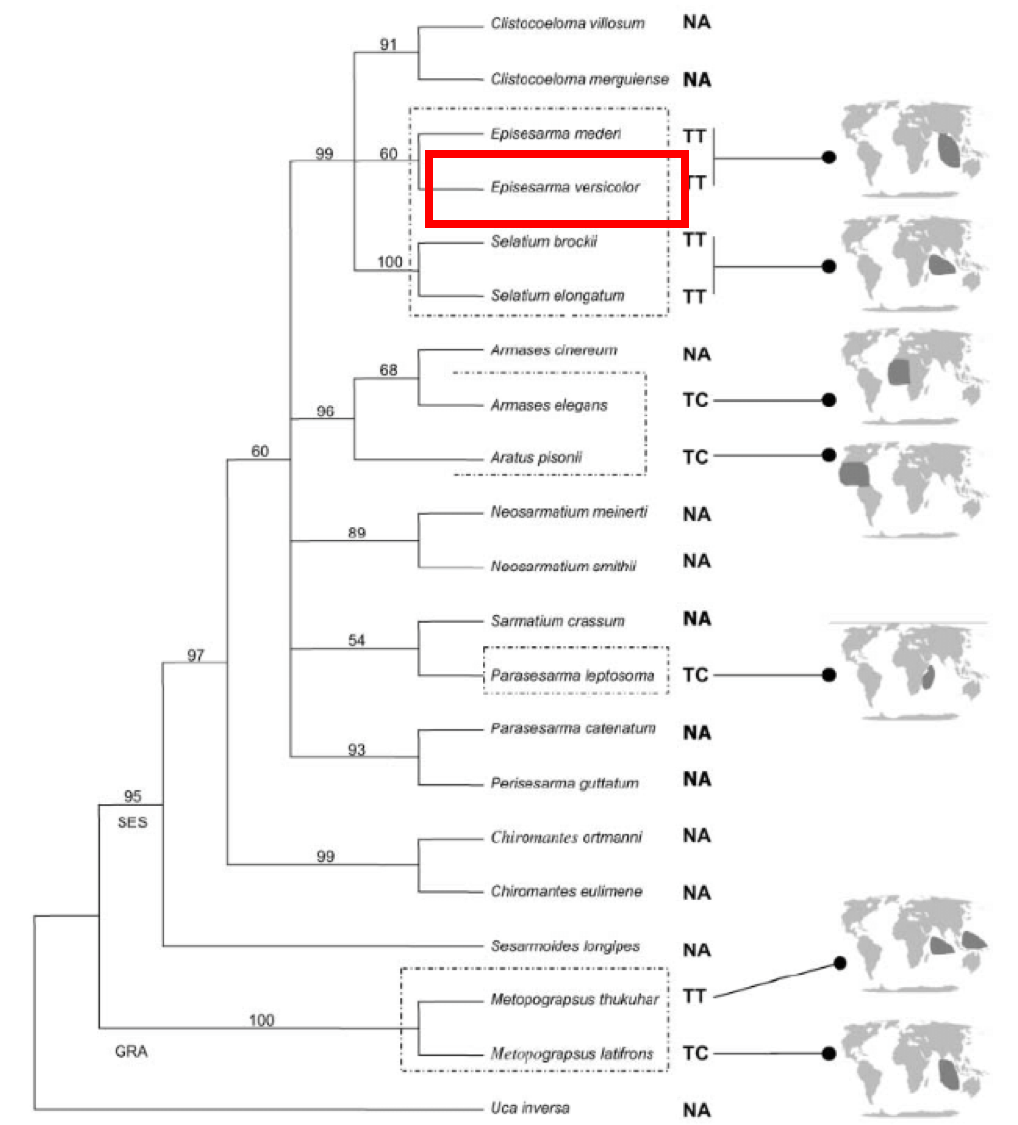
Figure 14. Phylogenetic tree (MP) of 21 crabs from the Grapsoidea superfamily using 2000 bootstrap replicates. Image credit: Fratini et al., published in "Evolutionary Ecology Research". Annotations (red box) added by page author Hariz.
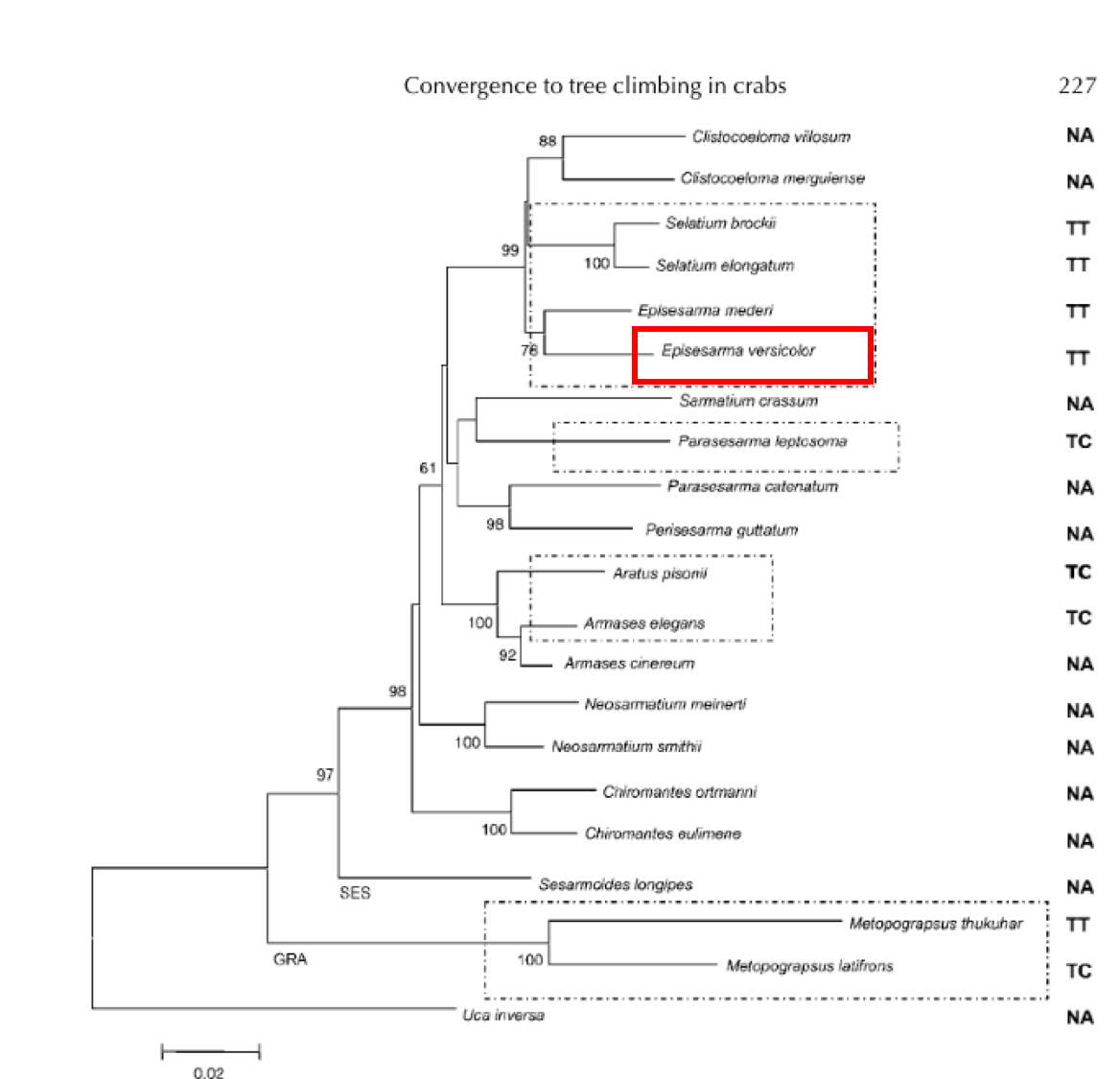
Figure 15. Phylogenetic tree (ML) of 21 crabs from the Grapsoidea superfamily with results based on the GTR+I+G model. Image credit: Fratini et al. Published in "Evolutionary Ecology Research" 7(2). Annotations (red box) added by page author Hariz.
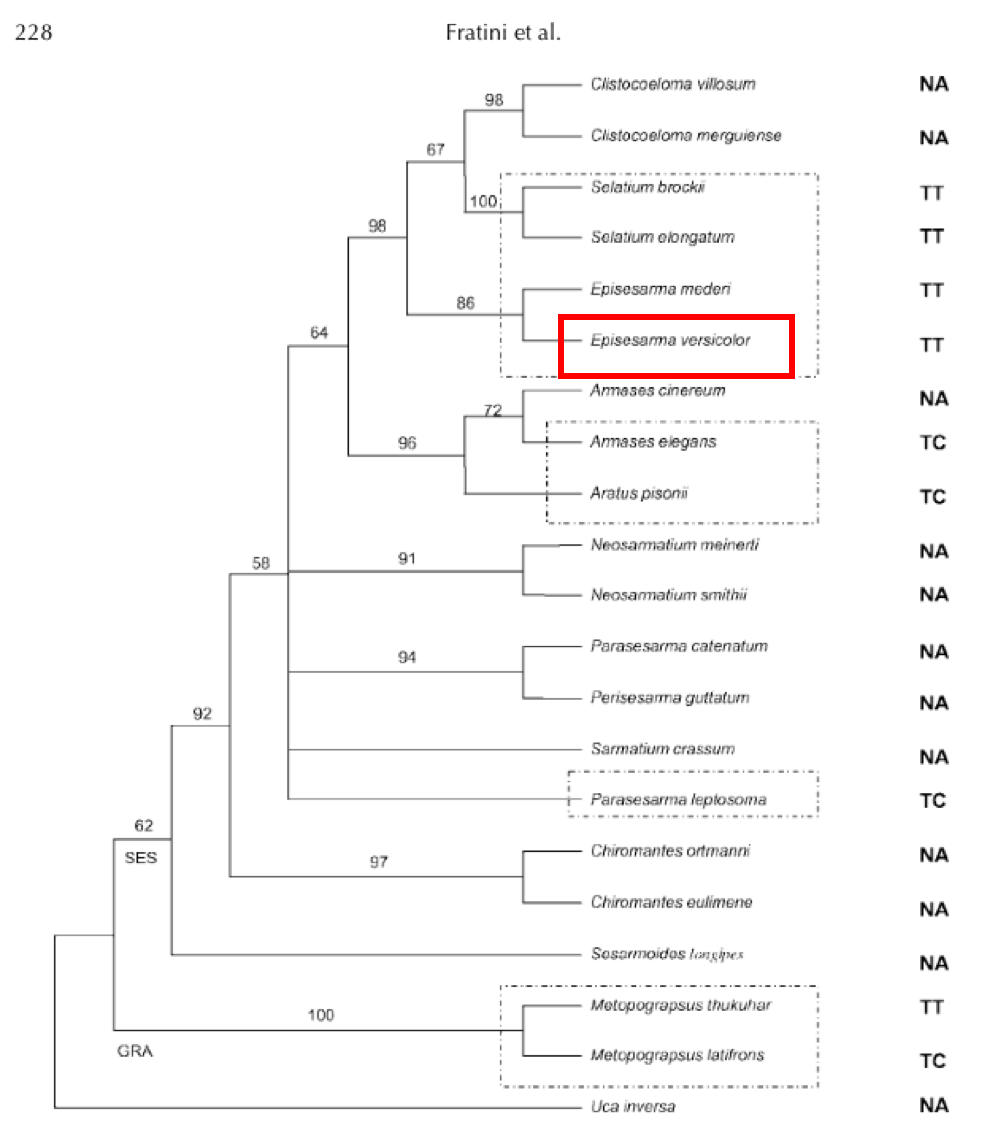
Figure 16. Phylogenetic tree (NJ) if 21 crabs from the Grapsoidea superfamily with results based on the GTR+I+G model. Image credit: Fratini et al. Published in "Evolutionary Ecology Research" 7(2). Annotations (red box) added by page author Hariz.
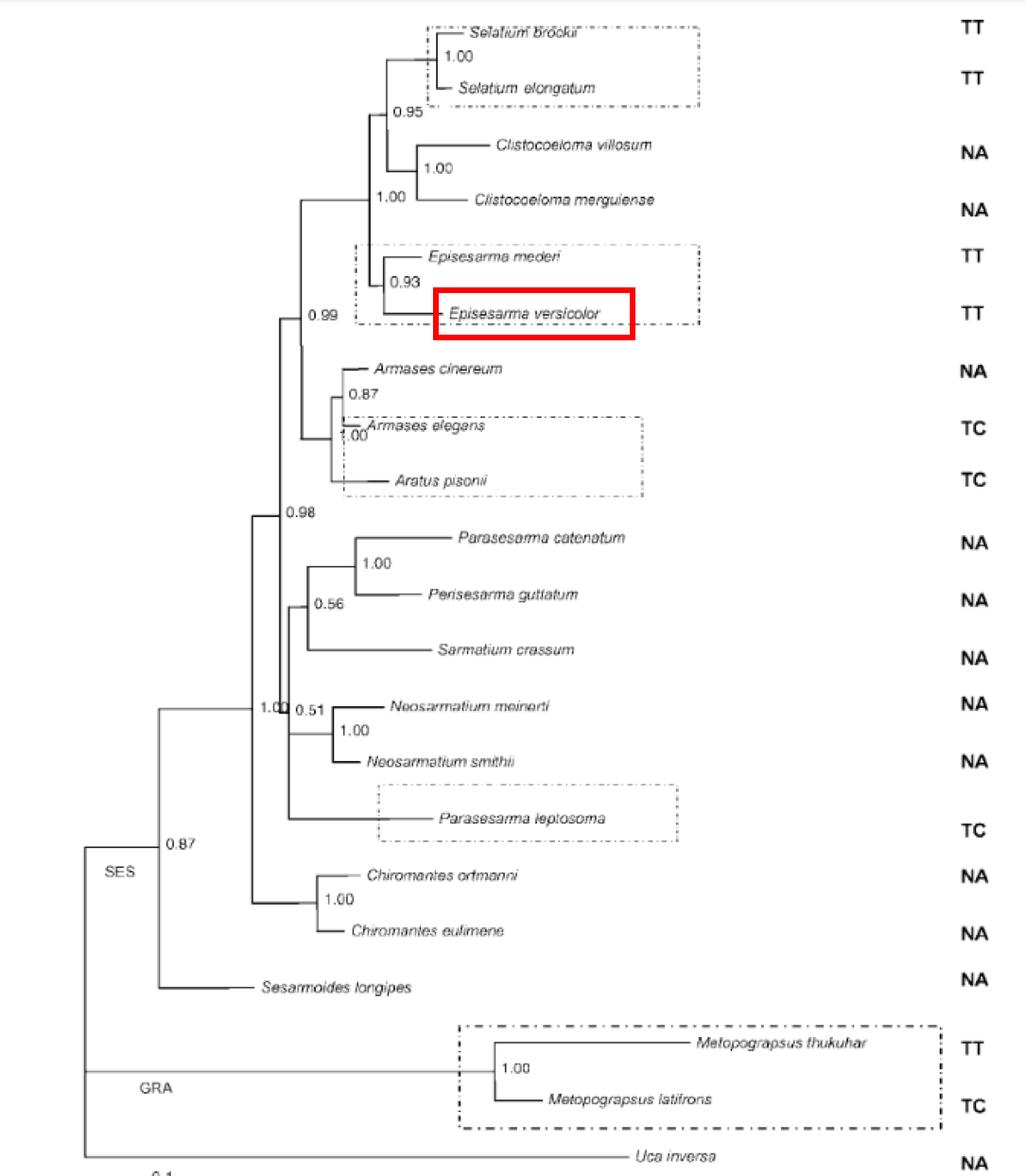
Figure 17. Phylogenetic tree (Bayesian) if 21 crabs from the Grapsoidea superfamily with results based on the GTR+I+G model. Image credit: Fratini et al. Published in "Evolutionary Ecology Research" 7(2). Annotations (red box) added by page author Hariz.
Literature and References
Text
- Clovegarden - Crabs.(2017). Retrieved on 10 November 2017, from http://www.clovegarden.com/ingred/seacrab.html
- Cornwall, J. (2014). Edible Crab Measuring Guide. Retrieved on 2017/11/01 from: http://helfordmarineconservation.co.uk/os/regulations/edible-crab.php
- Christy, J. H. (1987). Competitive mating, mate choice and mating associations of brachyuran crabs. Bulletin of Marine Science, 41(2), 177-1914
- Fratini, S., Vanini, M., Canicci, S., & Schubart, C. D. (2005). Tree-climbing mangrove crabs. A case of convergent evolution. Evolutionary Ecology Research, 7(2), 219-233.
- Gillikin, D.P., Schubart, C. D. (2004). Ecology and systematics of mangrove crabs of the genus Perisesarma (Crustacea: Brachyura: Sesarmidae).
- Holthuis, L. B. (1978). A collection of decapod Crustacea from Sumba, lesser Sunda Islands, Indonesia.
- Lee, B. Y., Ng, N. K., & Ng, P. K. L. (2015). The taxonomy of five species of Episesarma de Man, 1895, in Singapore (Crustacea: Decapoda: Brachyura: Sesarmidae). Raffles bulletin of Zoology (Vol. 2015)
- Lim, K., Murphy, D., Sivasothi, N., Ng, P.K.L. & Tan, K. (1999) A guide to the mangroves of Singapore II (PKL Ng and N Sivasothi, Eds.). Singapore Science Centre, Singapore.
- Ng, P. K. L. (1998). FAO species identification guide for fisheries purposes. The living marine resources of the Western Central Pacific (Volume 2), 1045-1155. Rome.
- Pickled Crab - A Small Forgotten Delight. (2017). Gastronautdiary.blogspot.sg. Retrieved on 10 November 2017 from http://gastronautdiary.blogspot.sg/2013/03/pickled-crab-small-forgotten-delight.html
- Robertson, A. I., Daniel, P. A. (1989). Decomposition and the annual flux of detritus from fallen timber in tropical mangrove forests, Limnology and Oceanography, 34, doi: 10.4319/lo.1989.34.3.0640.
- Schram, F. R. (2010). Treatise on Zoology. The crustacea - anatomy, taxonomy, biology / Volume 9, Eucarida: Euphausiacea, Amphionidacea and Decapoda (partim). Brill.
- Schubart, C. D., Cannicci, S., Vannini, M., & Fratini, S. (2006). Molecular phylogeny of grapsoid crabs (Decapoda, Brachyura) and allies based on two mitochondrial genes and a proposal for refraining from current superfamily classification. Journal of Zoological Systematics and Evolutionary Research, 44(3), 193-199. https://doi.org/10.111/j.1439-0469.2006.00354.x
- Sivasothi, N. (2000) Niche preferences of tree-climbing crabs in Singapore mangroves. Crustaceana, 73, 25–38
- World Register of Marine Species. (n.d.). Episesarma versicolor. Retrieved 1 December 2016 from http://marinespecies.org/aphia.php?p=taxdetails&id=444517
Media
- Crab Life Adoption. (2014). Life adoption, Crab biomimicry. Retrieved 11 November 2017 from http://crablifeadoption.weebly.com/uploads/2/8/1/8/28189401/3706389_orig.png
- Fratini, S., Vanini, M., Canicci, S., & Schubart, C. D. (2005). Tree-climbing mangrove crabs. A case of convergent evolution. Evolutionary Ecology Research, 7(2), 219-233.
- Lee, B. Y., Ng, N. K., & Ng, P. K. L. (2015). The taxonomy of five species of Episesarma de Man, 1895, in Singapore (Crustacea: Decapoda: Brachyura: Sesarmidae). Raffles bulletin of Zoology (Vol. 2015).
- Gastronaut Diary. (2017). Pickled Crab - A Small Forgotten Delight. Retrieved on 10 November 2017 from http://gastronautdiary.blogspot.sg/2013/03/pickled-crab-small-forgotten-delight.html
- Tree climbing crabs in Singapore Mangroves: Sungei Buloh Nature Park (n.d.) Mangrove.nus.edu.sg Retrieved 1 December 2017, from http://mangrove.nus.edu.sg/pub/wetlands/text/99-6-11.htm
- Special mention to LSM2251 Project group mate (Goh Yi Le and Germaine Chua) for photos.
[Invalid Include: Page not found: ]